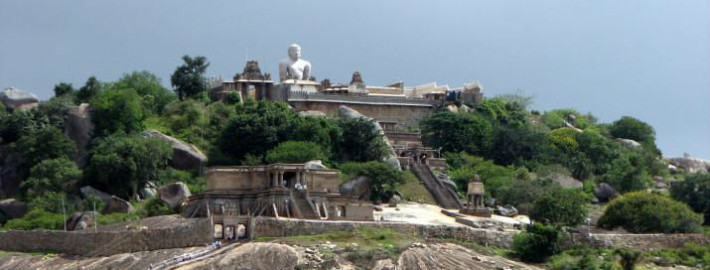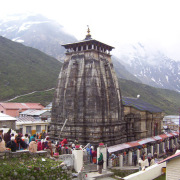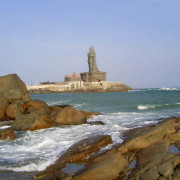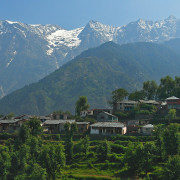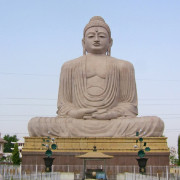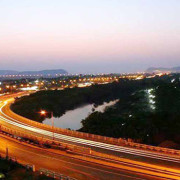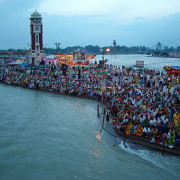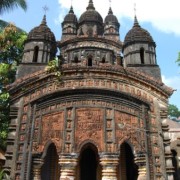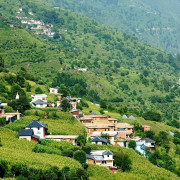Shravanabelagola, Karnataka – A famous Jain pilgrimage about 150 km from Bengaluru
The famous Jain pilgrimage centre Shravanabelagola is situated about 150 km northwest of Bengaluru. The Kannada word Shravana means Jain pilgrimage and Belagola means white pond. The town has been a prominent centre for Jain art, architecture, religion and culture for over two millennia. About two thousand years ago, Bhagawan Bhadrabahu, the earliest among the great Jain Acharyas came to Shravanabelagola from Ujjain, Madhya Pradesh, with his disciples to preach Jainism. Influenced by this ascetic, Chandragupta Maurya, the great emperor who ruled a large part of India, settled in this region, handing over the reins of his kingdom to his son.
Places to see at Shravanabelagola: Shravanabelagola offers quite a lot of attractions which include;
Vindhyagiri
The hill is about 470 feet above the ground and is one solid rock. It must be climbed barefoot. Most tourists use the ‘main steps’ from the town consisting of a dual flights of about 660 steps to the top, cutout in the rock. The 17.38 meter (58 ft) high monolithic stone statue of the Lord Gommateshwara, also referred to as Bahubali is located above this hill. The stone statue was installed and consecrated by Chavundaraya, the Prime Minister and Commander-in-Chief who served under the successive rulers- King Marasimha II, Rachamalla IV and Rachamalla V of the TalakadGangaKingdom in 981 A.D. The base of the statue has inscriptions in Kannada and Tamil, as well as the oldest evidence of written Marathi, dating back to 981 AD. The inscription praises the Ganga king who funded the effort, and his general Chavundaraya, who erected the statue for his mother. This statue is considered to be the world’s largest monolithic stone statue. It is carved beautifully from a single block of rock with accurate sense proportion and expression. On either side of Gommata stand two tall and majestic chauri bearers in the service of the Lord. One of them is a yaksha and the other one is a yakshi. These richly ornamented and beautifully carved figures complement the main figure. Carved on the rear side of the anthill is also a trough for collecting water and other ritual ingredients used for the sacred bath of the image. Around the statue is an enclosure of a pillared hall where one can find 43 images of Thirthankaras in different cloisters. There is also a figure of a woman called Gullakayajji sculpted with a good built and wearing exquisite ornamentation, typical of the sculptures of the Ganga period. There is also the Brahmadevaru temple atop the hill. Besides these there are the Odegal Basadi, Chowwisa Thirthankara Basadi, Chennana Basadi, Tyagada Brahmadevaru Kambha, Akhanda Bagilu and Gullakayajji.
Odegal Basti- (Trikuta Basti)
The Odegal Basti is so called because of the odegal or stone props used for strengthening against its basement walls. In the literary works the temple is known as the “Trikuta Basti” It’s the only Trikutachala (triple shrine) at Shravanabelagola.
Mahamasthakabhisheka
Mahamasthakabhisheka or the head anointing ceremony of the Lord Gommateshwara Bhagawan Bahubali have been ”performed once in every twelve years” in Jain dharmic cycle is part of ancient and Indian tradition. Today the ritual Mahamasthakabhisheka of Gommateshwara statue at Shravanabelagola is in memory of the first consecratory bath prathista abhisheka performed to the statue by the Ganga Prime Minister Chavundaraya and his guru Achaiya Sri Nemichandra Siddhantha Chakravarthi, under the inspiration of Chavundaraya’s mother Kalala Devi. The ceremony last here in February 2006 is the 87 of the series that commenced in the year 981 AD, dating back to the Indus Valley Civilization. Just on the eve of the event scaffolding is constructed to help the priests and devotees to go up and offer worship. Worship is done in accordance to Jain Agama. Hundreds of people and tourists participate in the rituals held over a period of twelve days. The statue of Lord Gommateshwara gets poured by 1008 kalashas (painted earthen pots- coloured colourfully in ceremonious style) of water, milk, butter, ghee, curd, sugar, almonds, tender coconut, sugarcane juice, rice flour, turmeric paste, jaggery, banana paste, kashaya (herbal concoction), shrigandha (sandal paste), chandana (coloured sandal paste), ashtagandha (8 varieties of sandal paste), saffron, marigold flowers, and precious stones, culminating in a spectacular shower of flowers from a helicopter. The wealthy devotees offer bids for the kalashas, to obtain them and perform Abhisheka.
Chandragiri
Shravanabelagola occupies a significant place in the Jain legacy of Karnataka, for being the place where Chandragupta, the founder of the Mauryan dynasty, became a Jain ascetic after relinquishing his throne. The place where Chandragupta breathed his last is named Chandragiri (Chikkabetta). It is a small hill is located just opposite to the Vindhyagiri hill.
The Cave of Bhadrabahu
The sacred feet of Sritakavalli are being worshipped even now. It is said that Chandragupta Maurya worshipped those sacred feet till his last days.
Kuge Brahmadevara Kambha
At the top of the pillar is seated the image of Brahma over it.
Kattlae Basadi
This is situated to the left of Parshwanatha Basadi and in fact this is the biggest of all the Basadis on this hill. Here one finds the image of Adinatha Thirthankara and also of Pampavathi in the Kaisale.
Chandragupta Basadi
It is situated to the north of Kattalae Basadi. This is perhaps the smallest of all the Basadis. The beautiful workmanship of architecture found in this monument relates to the 12th century.
Shasana Basadi
Because of the inscription in front of it, it is called like that. It has got a Garbhagruha, Sukhanasi and Navaranga. All are dedicated to the worship of Adinatha and Gomukha and Chakreshwari, the Yaksha and Yakshi.
Majjigana Basadi
Dedicated to worship of Ananthanatha, the 14th Thirthankara.
Chandraprabha Basadi
Located to the west of Shasana Basadi, it is dedicated to the worship of the Eighth Thirthankara, Chandraprabha. The images of Shyama and Jwalamalini, Yaksha and Yakshi are to be found.
Suparshwanatha Basadi
Seven headed serpent is carved over the head of the image.
Chavundaraya Basadi
This Basadi is said to have been got constructed in 982 A.D. by Chavundaraya as per inscription. It is dedicated to the worship of Neminatha Swamy, the 22nd Thirthankara. The monument reveals workmanship of the Ganga and the Hoysala periods. This is constructed as the most beautiful of all the Basadis.
Yeradukatte Basadi
It is located opposite to the Chavundaraya Basadi. The image of Adinatha is found inside with Yaksha and Yakshi.
Savathigandharvana Basadi
It is dedicated to the worship of Shanthinatha, the 16th Thirthankara. It is seen from the inscription on the pedestal of the image that this Basadi was got constructed by Shanthaladevi, the queen of Vishnuvardhana, in 1123 A.D.
Tyerina Basadi
It resembles a Ratha.
Iruve Brahmadevara Temple
The image of Brahma is carved out of a solid rock on a miniature scale.
Nearby attractions from Shravanabelagola: Shravanabelagola offers a number of places of attractions that are located nearby which include;
Halebidu
Situated at a distance of about 30kms from Shravanabelagola is a town of Halebidu. Halebidu is an interesting temple town of Karnataka. The temples of Halebid are renowned for their architecture.
Hassan
Located at a distance of 52kms from Shravanabelagola, is a quiet and peaceful town of Hassan. Hassan is well known for its Hassanamba Temple, which is believed to be 800 years old. The peaceful environs of Hassan are an ideal way to relax and unwind.
Belur
Another interesting place that you can visit on a day trip from Shravanabelagola is Belur. Situated at a distance of 60kms from Shravanabelagola, Belur is not just another temple town of Karnataka. Belur is popular for its Chennakeshava temple complex, which is dedicated to Lord ‘Chennakeshava’ (Vishnu) temple.
Things to do at Shravanabelagola: The huge monolithic statue of Lord Gomatheeswara will fill you with wonder. Visiting the Cave of Bhadrabahu is another experience of astonishment. The delicious South Indian and Jain or Marwadi cuisine is also worth relishing.
Best time to visit Shravanabelagola: The best time to visit Shravanabelagola is during the winter months, between October and February, as the weather gets really warm in the summer months.
How to go ?
By Air
The nearest airport to Shravanabelagola is the Bangalore airport, which is about 155kms from Shravanabelagola. From here you can either take a bus or hire a taxi to reach the religious town of Shravanabelagola.
By Rail
The nearest railway station to Shravanabelagola is Hassan, which is about 52kms away from Shravanabelagola. From here you can either hire a taxi or board a bus. However, please note that there are no direct buses from Hassan and you will have to change at Channarayapattana and from where you can take the bus to Shravanabelagola.
By Bus
Shravanabelagola is well connected to the major cities of Karnataka through state highways and district roads. There are regular bus services by Karnataka State Road Transport Corporation (KSRTC) to Shravanabelagola.
Where to Stay ?
This small town offers some decent choices to its visitors. Some options are:
Raghu Hotel: +91- 08176 – 257238
Hotel Yatri Nivas: +91- 08176- 257923
Note : Phone numbers given above are according to the information available with us. If you find any contact number/s given above is/are incorrect or not in use, please let us know.

